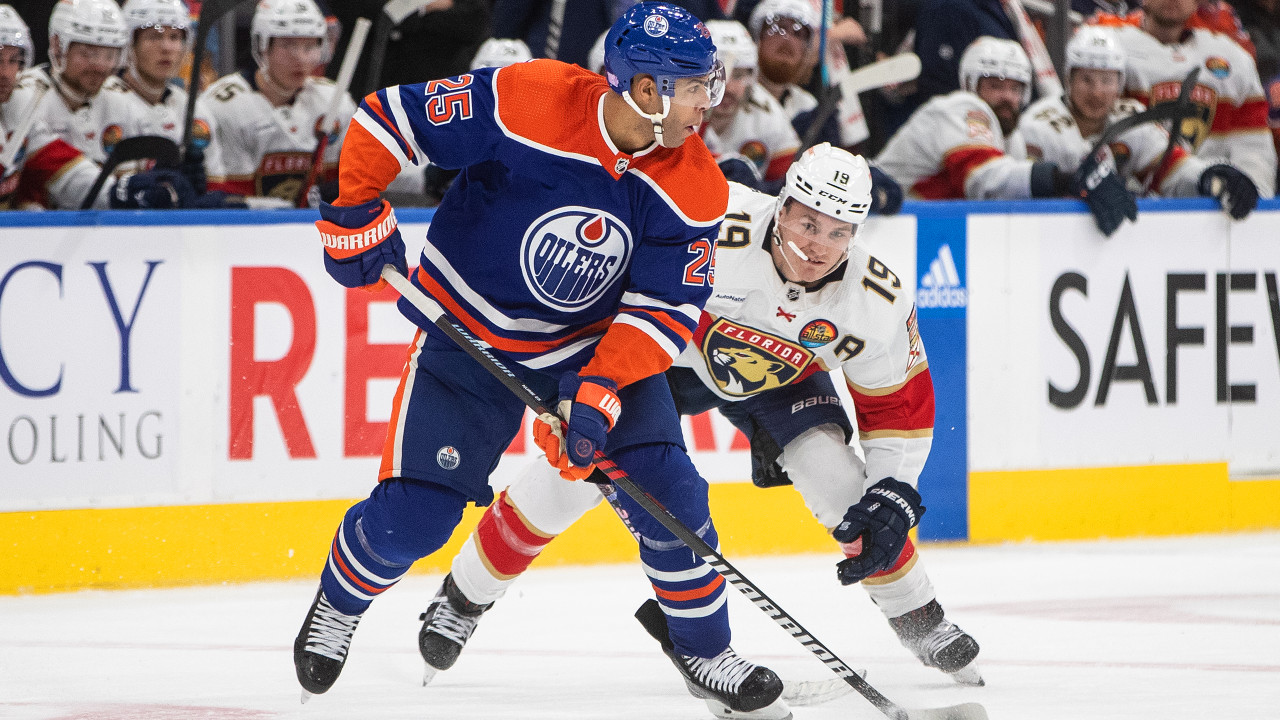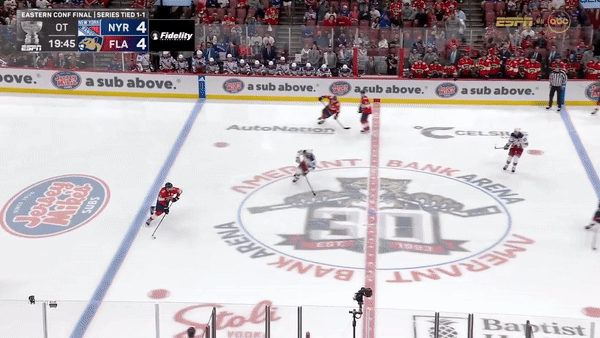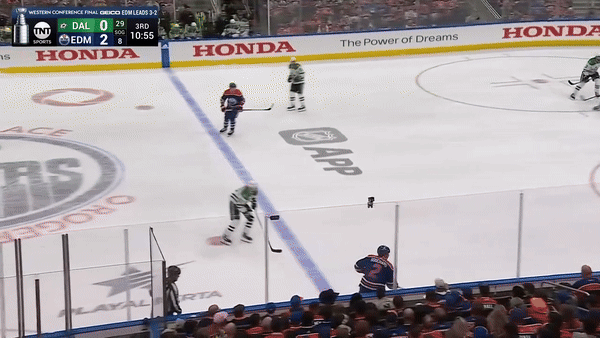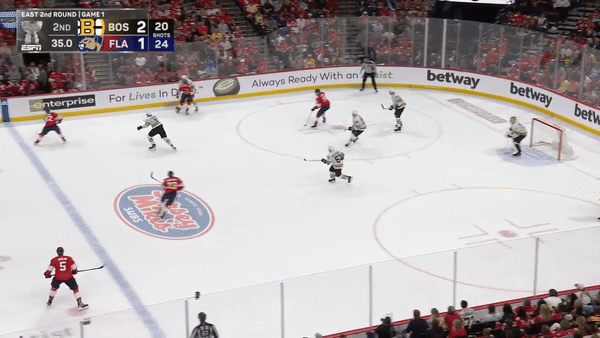
Love them or hate them (there doesn’t seem to be an in between), the Florida Panthers have looked dominant for the better part of three rounds this post-season. They’ve outskilled, outskated, and outwilled the Lightning, Bruins, and Rangers en route to a second consecutive Stanley Cup Final, frustrating the heck out of their opponents in just about every way.
That’s the bad news if you’re the Edmonton Oilers.
The good news is you now have three rounds worth of information to leverage in an effort to avoid the same fate.
Enter Kris Knoblauch and his coaching staff who are responsible for conducting a deep dive into how the Panthers play and devising a game plan accordingly.
Here’s what the Oilers’ bench boss said on Tuesday when asked about how his team is preparing for the matchup ahead:
“You can’t focus on everything. If you focus on everything, you end up focusing on nothing. It’s important that we give the guys the details that are important to play, but if we give them too much, it hampers their game.”
He then cited the following as the focus:
“What is Florida’s identity? What are they good at and what are the things we need to do well to eliminate their strengths? And the rest of it, we’ll just have to play our game.”
In pre-scout fashion, we’ll dig into some video and numbers (courtesy Sportlogiq) to break down the two areas that have largely driven Florida’s success in these playoffs through the lens of how the Oilers can combat them.
THE FORECHECK
Anyone who’s seen the Panthers play more than five minutes over the past month knows that this team has a penchant for making life miserable for opponents in their own end. Much of this misery can be attributed to a forecheck that doesn’t allow easy zone exits. Opponents have a 60.9 per cent exit success rate at 5-on-5 against Florida this post-season, which is the second lowest among all teams.
When you consider this tidbit and the Panthers’ high offensive zone loose puck recovery rate, it’s no surprise that they’ve spent the second highest percentage of time in enemy territory.
The speed and physicality of Florida’s forecheck jump out immediately, but upon closer inspection, it’s clear that a particular tendency is powering this area of success to a large degree: the use of rim dump-ins.
Florida dumps the puck in over half the time at 5-on-5 and over half of those dump-ins are rims, equating to roughly 23 per game (translation: a lot).
On a scale of most to least fun dump-ins to retrieve as a defender, the rim undoubtedly falls in the latter category. It’s not easy to corral a puck whipping along the wall, let alone make a quality play with it while under duress, especially against a team that leaves you with seemingly no good options and loves to lower the boom.
Below is an example of what Florida’s forecheck typically looks like on rims. The team basically plays a trap game involving heavy pressure, which generally assumes the following formation:
• One forward hounds the puck
• One forward provides high, strong-side support to cut off plays up the near wall
• One forward provides weak-side support to cut off reverses or plays up the far wall
• The defencemen aggressively pinch down as they see fit
Through three rounds, the Eastern Conference Champs have generated a ton of chances and scored several goals off both quick attacks and extended offensive zone sequences from forechecks initiated in this fashion.
So how can the Oilers counter this strength?
Aside from forcing the opposition to defend, the best way to combat a dangerous forecheck is to disrupt it before it begins. The Oilers can do so in two key ways:
1. Delay the dump-in
Simply put, throw off the puck carrier’s timing as he tries to gain the red line. Force him to make an extra move, alter his route, or bobble the puck by applying smart pressure in the neutral zone. Doing so will mess with the timing and momentum of his teammates by extension, who will have to either slow down, drift out of position, or go offside – all outcomes that favour Edmonton.
Steering the puck carrier to a poor spot in the neutral zone also leaves him chasing the play.
Here are two well-executed examples:
2. Delay the pressure
Similar idea here, but the moving parts without the puck are the primary focus. While it may seem insignificant, making a point of consistently running subtle interference – impeding a forechecker’s route or tying him up momentarily – can be a game-changer for the Oilers in terms of affording them more time, space, and options to facilitate clean exits and play 200 feet from their own end.
Florida’s earlier opponents found some success with this tactic, as we see in the ensuing clips.
A strong forecheck is predicated on everyone working in unison and if one individual is slow to arrive at the play or isn’t quite in the spot he should be, it throws the cohesion and effectiveness of the whole operation off.
Setting these “picks” likely benefits the Oilers from a wear and tear standpoint too. As much as the Panthers enjoy throwing their weight around, doing so isn’t as practical (or wise) when you’re late to the puck, unless you’re prepared to remove yourself from the play or potentially take a penalty.
And finally, a couple quick thoughts on how to handle Florida’s pressure in-zone:
• Avoid playing hot potato with the puck and making it a teammate’s problem
• Work to move it off the wall and don’t be afraid to use the middle of the ice (as we’ve seen, Florida seals the perimeter very well)
• Leverage short, low support from forwards
• Remember that a little poise can go a long way (the Leon Draisaitl special)
THE RUSH
I find the Panthers’ collective speed fascinating. Everyone seems to be in constant motion, yet still interconnected. Guys repeatedly win races to pucks, create quick counters, and attack together without hesitation.
Florida leads the playoffs in both chances and shots off the rush, and the squad’s defencemen are a major reason why. They jump to join plays and kickstart many sequences with their aggressive approach in all three zones.
In order to mitigate risk, it’s important for the Oilers to be aware of this pressure early and to manage the puck wisely, especially in the neutral zone and just inside the offensive blue line – the prime “thank you, I’ll take that” areas for the Panthers.
Additionally, Edmonton did a solid job of limiting Dallas’ dangerous rush game last round thanks in large part to disciplined positioning. By keeping the third forechecker above the puck often, the Oilers were able to clog up the neutral zone and slow the Stars down, which is something they’ll need to carry into the Final.
For comparison sake, watch how different the complexion of a rush can look when this player dives down and ends up caught deep with his linemates versus when he backs off to stay above the puck and protect the middle of the ice:
Given the active nature of Florida’s back end, Edmonton’s forwards will also need to backcheck hard as soon as there’s a change of possession in order to beat these defenders up ice and prevent odd-man rushes against.
Speaking of which, the Oilers have an excellent opportunity to exploit the Panthers’ aggressive style in this series. A team opting to defend by way of attacking is playing a high-risk, high-reward game that’s bound to backfire at certain points. Edmonton sits right behind Florida in rush chances and shots, and the Panthers have allowed the most rush goals in these playoffs.
Structurally, Florida likes to have one defenceman challenging at the lines in all zones while the other falls back. If the puck bypasses that first defender, it usually results in a break and a ton of open ice for the opposition, likely involving either numbers or a favourable matchup with a forward playing defence.
Some video evidence:
When Florida is caught in these situations, everyone trailing the play tends to overbackcheck, leaving the top of the zone available for a second or third layer of support to skate in and receive a pass for a quality look.
Fast and with active defencemen of their own, it’ll be interesting to see what kind of damage the Oilers can do off the rush in this series.
A FINAL THOUGHT
Coaches will make adjustments to their game plan as they gather more information each contest, yet no matter how much teams prepare, a good chunk of everything goes out the window once the puck is dropped.
And in a way, that’s the beauty of hockey. It’s exciting, unpredictable, and chaotic.
Let’s see what the 2024 Stanley Cup Final has in store.











